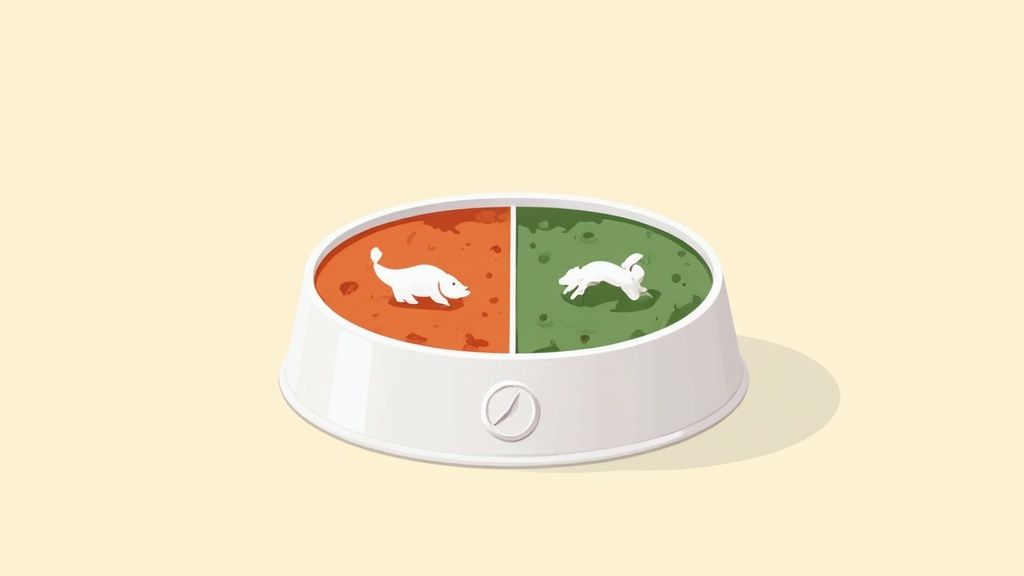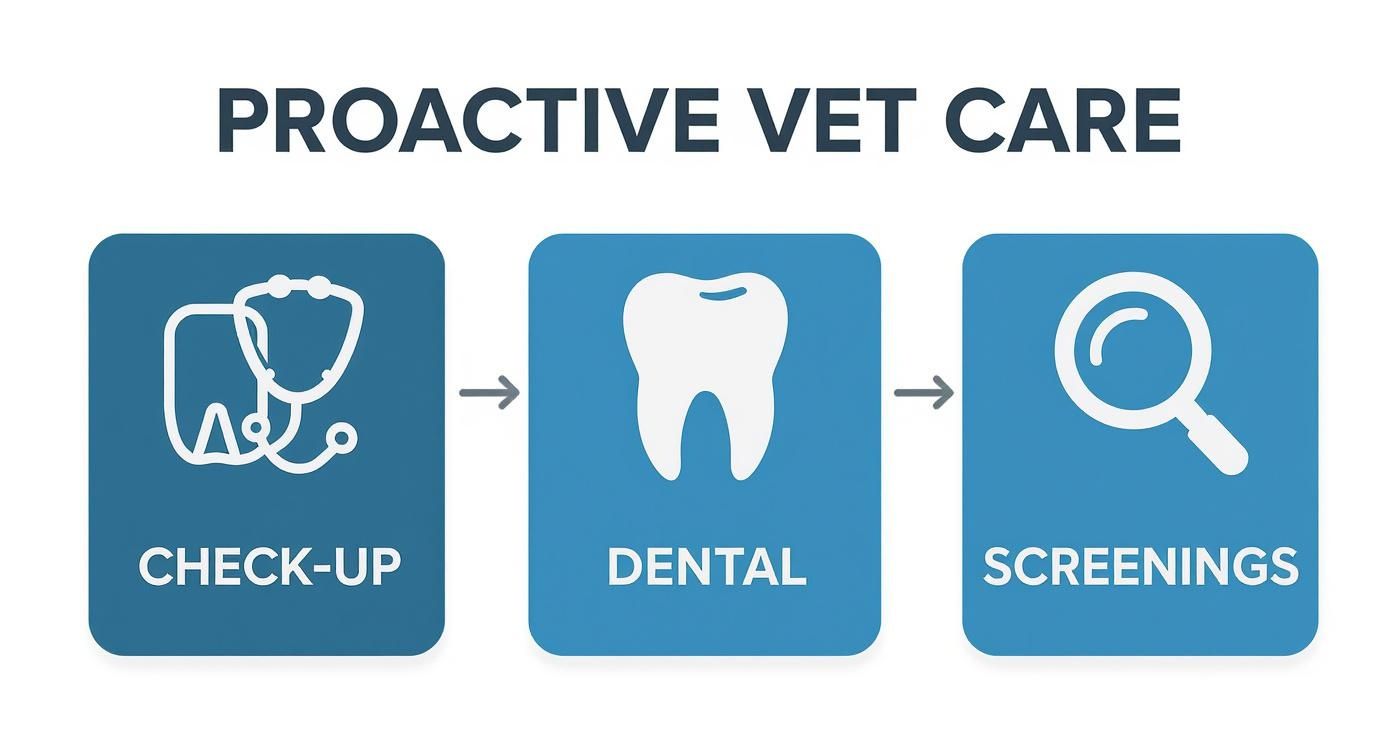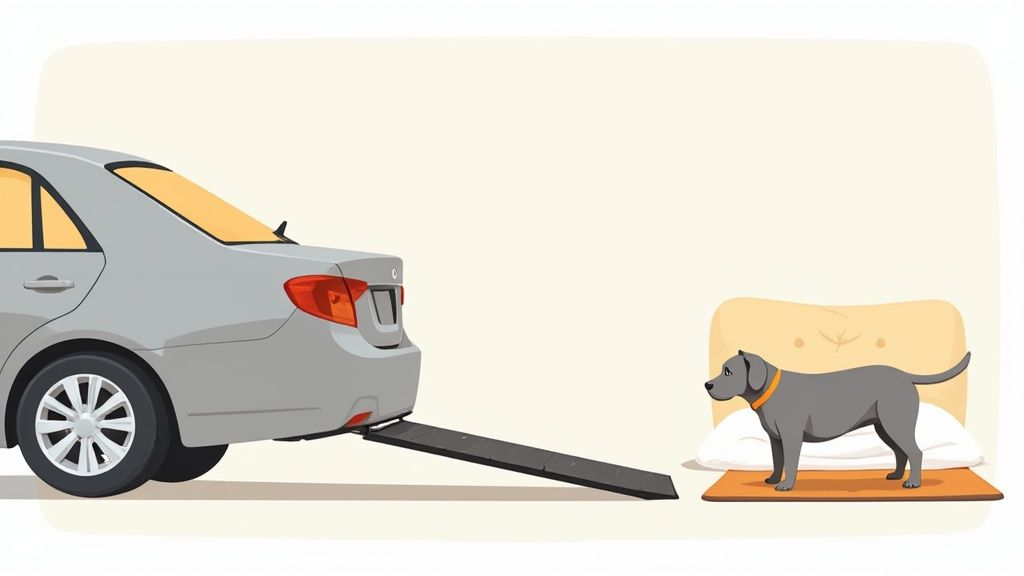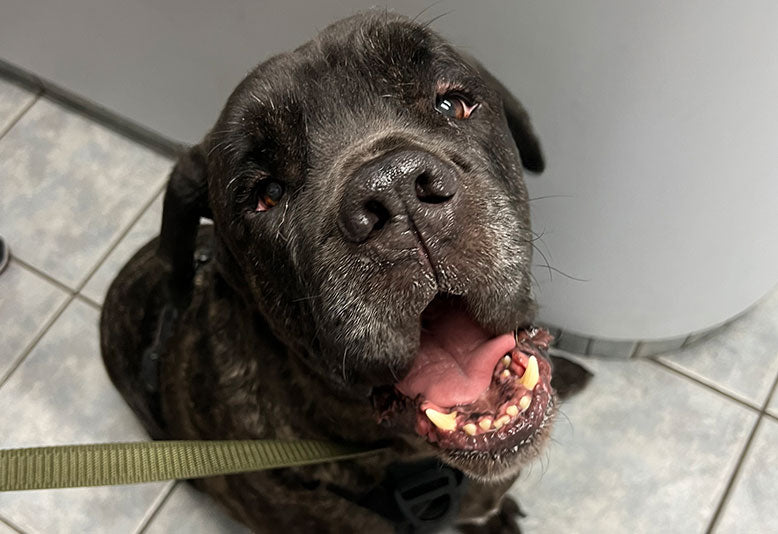
How to Make Your Dog Live Longer: A Practical Guide for Your Best Friend
It's a quiet moment every dog parent knows. You look over at your friend, maybe notice a little more grey around their muzzle or a new slowness in their step, and the thought hits you: How can I get more time with them?
If you've asked yourself that question, you're not alone. We understand that feeling deeply. We're not here to talk about miracle cures, but about the small, meaningful changes that can add up to more good days together. This journey is about honoring the incredible bond you share with practical, gentle steps that support a longer, healthier, and happier life for your companion.
Your Journey to More Good Years Together
Let's be clear: the goal isn't just more years. It's about more good years. It's about peaceful nights, happy tail wags, and the quiet comfort of your daily routines. It's about celebrating every small victory, whether that's a renewed interest in a favorite toy or just a good, long nap in a sunbeam. Small improvements matter.
The great news is that you're starting this journey with more knowledge than ever before. We've learned so much about canine health. In fact, over the last four decades, the average dog life expectancy has doubled in some places—a powerful testament to what better veterinary care and more knowledgeable owners can achieve together.
So, how do we build on that? We focus on five core areas that lay the foundation for a long, vibrant life for your best friend.
"We measure success in peaceful nights and moments of recognition. Small improvements can mean everything when you're navigating your dog's senior years together."
Each of these pillars is an opportunity to be proactive—to give your dog the support they need. To learn more about the specifics of caring for an aging companion, our comprehensive guide to senior dog care is a fantastic resource to check out.
The Pillars of Canine Longevity at a Glance
Think of these five areas as the cornerstones of your dog's long-term health. We'll be diving deep into each one, but here’s a quick snapshot of why they matter and how you can get started right away.
| Pillar of Health | Why It Matters for a Longer Life | Simple First Step |
|---|---|---|
| Proactive Nutrition | Fuels every cell in their body and helps maintain a healthy weight, reducing stress on joints and organs. | Read your dog’s food label to ensure a high-quality protein is the first ingredient. |
| Consistent Vet Care | Allows for early detection of potential health issues when they are most manageable. | Schedule their next annual or semi-annual wellness check-up today. |
| Mental Enrichment | Keeps their mind sharp, supports mental clarity, and helps maintain cognitive function as they age. | Introduce a simple puzzle toy with their favorite treat for 5-10 minutes a day. |
| Adapted Exercise | Maintains muscle mass and joint mobility without causing strain, supporting physical comfort. | Swap one long, strenuous walk for two shorter, gentle strolls this week. |
| Safe Environment | Reduces the risk of injury and minimizes daily physical stress on an aging body. | Place a non-slip rug on a slick floor where your dog often walks. |
By thoughtfully addressing these foundational elements, you're giving your dog the best gift possible: your care, your attention, and a true commitment to their well-being. Now, let's explore how you can put these ideas into action.
Get Your FREE Dog Brain Health Guide

Get instant FREE access to today's top ways to help your best friend live a longer, healthier, happier life.
- 39 value-packed pages of expert insights
- Early-detection tips for cognitive decline
- Top brain-boosting superfoods
- Vet-approved mental sharpness strategies
- Fun IQ tests for your dog
Building Health From the Inside Out Through Nutrition
What you put in your dog's bowl is the cornerstone of their well-being. Think of it as the foundation for everything else—every meal provides the building blocks for strong muscles, a sharp mind, and a healthy immune system. Making thoughtful choices here is one of the most direct ways you can support your dog's long-term health and vitality.

There’s no single “perfect” food, because every dog is an individual. The nutritional needs of a bouncy puppy are worlds apart from those of a senior dog enjoying their golden years. A high-octane Border Collie running agility courses needs different fuel than a Bulldog who's a professional napper. The first step is always to consider your dog's specific life stage, breed, and daily activity level.
One of the most critical factors for a long life is maintaining a healthy weight. Those extra pounds aren't just cosmetic; they put a serious strain on joints, the heart, and other vital organs, which can impact their lifespan. In fact, one landmark study found that dogs kept at a lean body weight lived, on average, nearly two years longer than their overweight peers.
"Your dog gave you their best years—now give them yours. Thoughtful nutrition is a direct way to honor that bond every single day."
Simply managing their weight through proper portions and quality food is one of the most powerful things you can do for their long-term wellness. It’s a simple change with a massive impact.
Decoding the Dog Food Label
Walking down the pet food aisle can feel overwhelming. The brightly colored bags make all sorts of claims, but the real story is always in the fine print on the back. Learning to read an ingredient list gives you the power to see past the marketing and choose what truly supports your dog.
Here are the key things we look for on a label:
- High-Quality Animal Protein: The very first ingredient should be a named meat source, like "deboned chicken," "lamb meal," or "salmon." This ensures your dog gets the essential amino acids they need to build and maintain lean muscle, which becomes even more critical as they get older.
- Healthy Fats and Fatty Acids: Look for ingredients like fish oil (a fantastic source of omega-3s), flaxseed, and chicken fat. These provide energy, and omega-3s like EPA and DHA are champions for supporting joint health and brain function.
- Wholesome Carbs and Fiber: Digestible carbohydrates like sweet potatoes, brown rice, and peas offer a steady release of energy. Meanwhile, fiber from sources like beet pulp is crucial for keeping their digestive system running smoothly.
- Antioxidant-Rich Fruits & Veggies: When you see ingredients like blueberries, carrots, and spinach, it's a great sign. These foods provide natural antioxidants that help protect the body's cells from damage—a natural part of the aging process.
When you prioritize these ingredients, you’re not just filling their bowl; you’re fueling their body from the inside out.
What to Avoid in Your Dog’s Food
Just as important as what's in the food is what's left out. Some ingredients offer little nutritional value and can even be detrimental to your dog's health over time. Keep an eye out for vague terms, artificial additives, and low-quality fillers.
Try to steer clear of foods that list these on the label:
- Unnamed "Meat" or "Meat By-Products": Vague terms like "meat and bone meal" can hide inconsistent, low-quality protein sources. You always want to see a specific animal named.
- Artificial Preservatives, Colors, and Flavors: Chemicals like BHA, BHT, and ethoxyquin, along with artificial colors (like Red 40) and flavors, serve no nutritional purpose and are best avoided.
- Excessive Fillers: Ingredients like corn, wheat gluten, and soy are often used as cheap fillers. While not necessarily harmful to all dogs, they offer far less nutritional value compared to higher-quality complex carbs.
Choosing the right food is a huge step, but sometimes, even the best diets can use an extra boost. For a closer look at how specific nutrients can complement your dog's meals, feel free to explore our guide on canine nutrition and supplements. This lets you build a truly personalized plan for your dog's unique needs, creating a strong foundation for many more good years together.
Partnering with Your Vet for Proactive Wellness
Your veterinarian is so much more than the person you call when your dog is sick. Think of them as your co-pilot on this journey. It's easy to fall into the habit of only visiting for shots or when something is clearly wrong, but the real progress happens with proactive, preventative care. Regular wellness exams are your best tool for catching health issues early.
For senior dogs, we know those check-ups can feel like they come around fast. Shifting from yearly to twice-yearly visits might seem like a lot, but it’s one of the kindest, most effective things you can do. These appointments establish a solid health baseline, making it much easier for your vet to notice the small, subtle changes that could signal a bigger issue down the road.
"Think of these visits as a proactive strategy session. You and your vet are a team, mapping out a long and healthy future for your best friend, one check-up at a time."
This team approach turns a routine appointment into a powerful opportunity. You’re no longer just reacting to problems; you're actively managing your dog's health and supporting more good years in their life.
Making the Most of Every Vet Visit
We’ve all been there—you walk into the exam room, and your mind goes blank. All those little things you noticed during the week suddenly vanish. A little prep work can completely change the dynamic of your visit. After all, you’re the expert on your dog’s day-to-day life, and your observations are a critical piece of their health puzzle.
Before you head to your next appointment, try jotting down a few notes on:
- Behavioral Changes: Have you noticed any new anxieties, like pacing at night or a new fear of thunderstorms? We understand those 3 AM worries. Sometimes, a subtle shift in behavior is the first clue to physical discomfort or cognitive changes.
- Mobility and Comfort: Is your dog a bit creakier when they get up in the morning? Do they hesitate before hopping on the couch? Mentioning these small details can get a joint health conversation started early.
- Appetite and Thirst: Are they suddenly leaving food behind, or have they become a water-bowl fanatic? Changes here can be important flags for metabolic issues.
- Dental Health: Noticed some seriously funky breath? Or that they’ve stopped chewing on their favorite tough toy? Never just write off "doggy breath" as a normal part of aging.
Talking about new behaviors is particularly vital. If you’re seeing sudden restlessness or fear, our article on understanding canine anxiety medications can give you some background to bring up with your vet.
Essential Screenings for Senior Dogs
As your dog gets older, their health needs evolve. Proactive screening tests are fantastic for catching issues simmering below the surface, long before your dog ever shows obvious symptoms. This gives you far more options and a much better outlook. Ask your vet about a senior wellness panel—it’s an incredible tool for getting a comprehensive snapshot of your dog’s internal health.
These panels almost always include:
- Complete Blood Count (CBC): This is a foundational screening that looks at red and white blood cells. It gives your vet a window into your dog’s immune system and can flag things like infection or inflammation.
- Blood Chemistry Panel: This is the workhorse of a senior panel. It assesses the function of major organs like the kidneys and liver and checks blood sugar and electrolyte levels, which are crucial for spotting common age-related conditions.
- Urinalysis: A simple urine test can tell you a surprising amount about kidney function and can easily detect urinary tract infections or other metabolic problems.
- Thyroid Hormone Testing: Hypothyroidism (an underactive thyroid) is common in middle-aged and older dogs. It can be the hidden culprit behind everything from low energy and weight gain to skin issues.
Why Dental Health is Non-Negotiable
This is one of the most overlooked—and most important—parts of your dog's overall health. Poor dental hygiene isn't just about stinky breath; it's a direct threat to their longevity.
When plaque and tartar build up, the gums can become inflamed, creating a pathway for bacteria to enter the bloodstream. From there, this oral bacteria can travel to and affect vital organs, including the heart, liver, and kidneys.
Consistent dental care, from professional cleanings to at-home brushing, isn't just cosmetic. It's a powerful preventative tool that supports your dog's entire body. By working with your vet on a solid dental plan, you are actively safeguarding their systemic health for years to come.
Keeping Their Mind Sharp and Spirit Bright
A long, happy life isn't just about physical health. We have to keep our dogs' minds active and engaged, too, especially as they get on in years. You might have already seen those quiet, confusing moments—your dog staring at the wrong side of the door, wandering into a room and seeming to forget why, or getting lost on a walk you've taken a thousand times.
These moments can be heartbreaking. It’s easy to spiral down a late-night internet rabbit hole, but please know, you're not alone. Many of these behaviors come from normal, age-related changes, not unlike a person forgetting where they left their keys. Supporting their mental clarity is every bit as important as keeping their body strong.
"We understand the worry that comes when your dog stands at their bowl, confused. Small improvements in their alertness and engagement are worth celebrating—they're a sign you're on the right path together."
Gentle, consistent mental enrichment is a fantastic way to keep their mind engaged and their spirit bright. This isn’t about running them through a tough training routine; it’s about giving them simple, fun challenges that tap into their natural instincts and add a little joy to their day.
Nurturing an Active Mind
Keeping your dog's brain working helps preserve those critical neural pathways. Think of it as a muscle—gentle use helps maintain it. The trick is to adapt activities to their physical limitations, focusing on low-impact fun that still gets the gears turning.
Here are a few simple but effective ways to support their cognitive health:
- Puzzle Toys: Start with something basic like a "snuffle mat" or a slow-feeder bowl. Hiding a few high-value treats inside encourages them to use their nose and brain to solve a simple problem, giving them a great mental workout.
- Scent Games: You don’t need anything fancy for this. Just hide a favorite toy or a healthy treat under a blanket and encourage them to "find it." This taps into their powerful sense of smell, which is deeply wired into their brain's memory centers.
- Learning New Tricks: You absolutely can teach an old dog new tricks, and it's great for them! Simple, low-impact commands like "touch" (having them touch their nose to your hand) or a gentle "paws up" on a low stool can build confidence and keep their mind sharp.
These aren't just games; they're moments of connection. They reinforce your bond and give your dog a sense of purpose and accomplishment, which is so important for their emotional well-being.
Mental enrichment can be adapted for any age, ensuring your dog stays engaged throughout their life.
Mental Enrichment Ideas for Every Age
| Activity Type | Best for Puppies & Adults | Best for Seniors | Key Benefit |
|---|---|---|---|
| Puzzle Feeders | Complex, multi-step puzzles to challenge their problem-solving skills. | Simple snuffle mats or basic treat-dispensing balls. | Encourages natural foraging instincts and slows down eating. |
| Scent Work | "Find it" games with hidden toys or treats around the house or yard. | Hiding a treat under one of three cups and having them guess. | Stimulates the brain's olfactory center, a powerful memory tool. |
| New Skills | Learning agility basics, complex tricks like "roll over" or "play dead." | Gentle, low-impact tricks like "touch," "watch me," or a simple spin. | Builds confidence and strengthens the neural pathways for learning. |
| Interactive Play | A vigorous game of fetch or tug-of-war. | A gentle game of hide-and-seek or rolling a soft ball. | Reinforces your bond and provides both physical and mental stimulation. |
By tailoring activities to your dog's current abilities, you ensure they can always participate, feel successful, and stay mentally fit.
The infographic below shows how the core pillars of proactive vet care—check-ups, dental health, and screenings—create the foundation for overall wellness, which in turn supports cognitive health.

This really drives home how a holistic approach is key; taking care of their body through a partnership with your vet is directly tied to keeping their mind clear as they age.
The Role of Targeted Nutritional Support
When you see those moments of confusion, it's often tied to reduced blood flow and nutrient delivery to the brain. Just like their aging joints need extra support, so does their brain. This is where targeted nutrition can make a real, noticeable difference.
Certain natural compounds have been shown to support brain health. For example, ingredients that promote healthy circulation, like beet root powder, help make sure the brain gets the oxygen and nutrients it needs to work properly. Other components, such as Phosphatidylserine, which is a form of brain cell support, can help maintain the structure and communication of those cells.
This is all about giving their brain the gentle nutritional boost it needs to maintain clarity. It’s not a magic fix, but a way to support them in having more good days—days where they remember the path to their favorite sunny spot or greet you with that familiar spark in their eyes. If you want to learn more, we break down the signs and support for cognitive decline in dogs in our detailed article.
By combining simple mental enrichment with thoughtful nutritional support, you’re creating a powerful strategy to not only help your dog live longer but, just as importantly, live better. You're actively helping them stay present, engaged, and connected to the family they love so much.

Support Your Dog's Brain Health with NeuroChew™
As mentioned in this article, NeuroChew is the first dog chew designed to support both cognitive function and healthy circulation. Perfect for dogs showing early signs of cognitive decline or for proactive brain health support.
Adapting Movement and Home Life for Senior Dogs
Movement is life. We’ve all heard that, but for our senior dogs, the right kind of movement becomes the key to a long, comfortable life. Those five-mile hikes you both used to love might be too much for their aging joints now. The goal isn't about endurance anymore; it's about consistency and gentle activity that keeps them strong and happy without causing discomfort.

It’s tough watching your once-unstoppable companion slow down. We get it. But adapting their physical routine isn't about giving up—it's about giving them exactly what they need in this new chapter. A few short, frequent walks on soft grass are so much kinder to their joints than one long trek on hard pavement.
This shift is a powerful way to show your love. You're ensuring they stay active and engaged without pushing them past their limits, preserving their comfort and mobility for years to come.
Rethinking Your Exercise Routine
Learning to read the subtle signs of fatigue is one of the best things you can do for your old friend. If your dog starts lagging behind, panting more than usual, or seems extra stiff after a walk, that's their way of telling you it's time to scale back. It’s not a failure on anyone's part, just a natural progression on their journey.
Here are a few low-impact alternatives to keep them moving comfortably:
- Gentle Walks: Instead of one long haul, try two or three shorter walks of about 10-15 minutes each. This keeps their joints lubricated without causing exhaustion.
- Swimming: If you have access to a lake, a pool, or even a canine hydrotherapy center, swimming is fantastic. It’s a non-weight-bearing exercise that builds muscle without stressing their body.
- Indoor Play: Simple games like "find the treat" or a gentle game of fetch down a carpeted hallway can provide great mental and physical stimulation, especially on bad weather days.
We start to measure success differently. It's in their ability to comfortably get up for a drink of water or greet you at the door with a happy tail wag. These small moments of mobility are everything.
On top of adjusting their exercise, targeted joint support can make a world of difference. A quality supplement can help maintain cartilage and cushion their joints from the wear and tear of daily life. You can learn more about the benefits of glucosamine dog chews and how they support long-term joint health.
Creating a Safer Home Sanctuary
As your dog’s mobility changes, their environment needs to evolve, too. Your familiar home can suddenly become a minefield of challenges. Slick hardwood floors can feel like an ice rink, and a simple flight of stairs can look like a mountain. Small, thoughtful adjustments can dramatically reduce their daily physical stress.
These simple modifications will help turn your home into a true senior-dog sanctuary:
- Non-Slip Surfaces: Lay down runners or area rugs on hardwood, tile, or laminate floors. Pay special attention to their main pathways, like from their bed to their water bowl. This gives them the traction to walk confidently.
- Orthopedic Bedding: A high-quality orthopedic bed is a must. It cushions aching joints from hard floors and promotes deeper, more restful sleep.
- Ramps and Steps: Pet ramps are a game-changer for getting into the car or onto the couch without the jarring impact of jumping. Small pet steps can also give them safe access to their favorite nap spots.
- Elevated Feeders: Raising their food and water bowls just a few inches can significantly reduce strain on their neck and back, making every meal more comfortable.
These adjustments are more than just practical fixes; they are daily acts of compassion. You're anticipating their needs and creating a space where they can navigate their world with dignity, helping to ensure your dog lives longer and happier right at home with you.

Real Results: How NeuroChew Helped Brutus Regain His Mental Clarity
Brutus was getting disoriented at night. After starting NeuroChew, he's more happy during the day and steady at night. He's back to his old self!
Know Your Dog's Breed, Know Their Needs
Every dog is one-of-a-kind, but their breed gives us an incredible roadmap to their health. This isn't about putting them in a box; it's about being a smarter, more proactive owner. If you're serious about helping your dog live a longer, healthier life, you have to start with the genetic hand they were dealt.
Let's be honest: the way a Great Dane ages is worlds away from a tiny Jack Russell Terrier. This simple fact changes everything—from the conversations you have with your vet to the food you put in their bowl and the subtle signs you watch for as they get older.
This isn't about anxiously waiting for problems to appear. It's about quiet awareness. We know your dog is family. This knowledge is just one more tool in your toolbox to give them the best care possible, celebrating what makes them unique every single day.
What to Watch for With Certain Breeds
Some breeds are simply more prone to specific health issues. Knowing what they are ahead of time means you can focus on prevention and early support, which can make all the difference in their quality of life down the road.
Here are a few well-known examples:
- Labrador & Golden Retrievers: These wonderful dogs are known for joint problems like hip and elbow dysplasia. Keeping them lean from puppyhood and focusing on joint-friendly nutrition is a great support strategy.
- German Shepherds: Like Retrievers, they can be prone to hip dysplasia. They also face a risk of degenerative myelopathy, a serious spinal cord condition. Consistent, low-impact exercise is key to keeping their supportive muscles strong.
- "Flat-Faced" Breeds (French Bulldogs, Pugs, etc.): Those adorable smooshed faces can cause serious breathing problems (Brachycephalic Obstructive Airway Syndrome). You have to be incredibly careful with exercise, especially when it’s hot outside.
- Cavalier King Charles Spaniels: This breed can be susceptible to a heart condition called Mitral Valve Disease (MVD). Regular heart check-ups with your vet are absolutely essential for early detection.
Your dog gave you their best years—now you can give them yours by understanding their unique needs. Proactive care tailored to their breed is one of the most loving things you can do.
The Reality of Breed Lifespans
The lifespan gap between different breeds is significant, and it’s proof that a "one-size-fits-all" approach to aging just doesn't cut it.
An eye-opening study from the Royal Veterinary College analyzed data from over 30,000 dogs and laid it all out. They found that Jack Russell Terriers live an average of 12.7 years, while flat-faced breeds like French Bulldogs average a challenging 4.5 years. This isn't just a statistic; it's a call to action. You can learn more about the research on canine life expectancy to see where your dog might fall.
Armed with this information, you and your vet can build a truly personalized wellness plan. It’s a plan that anticipates your dog's future needs, prioritizes prevention, and gives them the best possible shot at a long, comfortable, and joy-filled life with you.
Your Top Questions About Helping Your Dog Live Longer
When you love a dog, you start thinking about the future. It's only natural to have questions pop into your head, often in the middle of the night, about how to give them the longest, happiest life possible. You're not the only one. Let's tackle some of the most common questions we hear from fellow dog parents.
Is There One "Magic Bullet" Thing I Can Do?
If we had to pick just one thing, it would be this: keep your dog at a lean, healthy body weight. This is probably the single most powerful lever you can pull to support their lifespan.
Carrying extra pounds puts a massive strain on their entire body, contributing to everything from arthritis and joint discomfort to serious metabolic conditions. It's not about crash diets; it's about consistent portion control and the right kind of daily exercise. This simple commitment can make a world of difference.
Do Mixed-Breed Dogs Really Live Longer?
We've all heard the "hybrid vigor" theory, and while there's some truth to genetic diversity being a good thing, the real picture is a bit more complicated. Size and the specific health issues common in certain breeds often have a much bigger impact than whether a dog is a purebred or a mix.
Interestingly, a large-scale study in the UK actually found purebreds lived to an average of 12.7 years, while crossbreeds averaged 12.0 years. If you're curious about the data, you can read more about these dog longevity findings yourself.
What does this mean for you? Don't get hung up on breed status. Focus on what you can control for your individual dog: their diet, their activity level, and staying on top of preventative vet care. That’s what truly moves the needle.
When Is It Time to Start Senior Care?
The best time to start thinking about senior care is before you actually see the signs of old age. A good rule of thumb is that a dog enters their senior years in the last 25% of their breed’s expected lifespan.
This looks different for every dog. A Great Dane might be considered a senior at just 5 or 6 years old, whereas a little Chihuahua might not hit that milestone until they're 8 or 10.
Start talking to your vet about a senior wellness plan as they approach this stage. This often involves switching to a senior-specific diet, increasing check-ups to twice a year, and being more proactive about their comfort and mobility. A little early support goes a long way in keeping them happy and sharp.
At Furever Active, we created NeuroChew™ to give your dog natural brain health support, helping them stay engaged and connected with you. It’s all about supporting more good days, together.
Share This Article

Support Your Dog's Brain Health with NeuroChew™
The first dog chew that supports both brain function and healthy circulation. Perfect for dogs of all ages.
- Enhances cognitive function & mental clarity
- Reduces anxiety without sedation
- Supports healthy blood circulation
- Made in USA with natural ingredients
60-Day Money-Back Guarantee • Free Shipping







